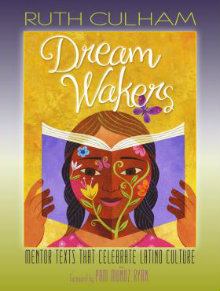Writer’s Workshop with Latino Mentor Texts
Dream Wakers: Mentor Texts That Celebrate Latino Culture
By Ruth Culham
(Stenhouse, 2016 – Learn more)
Reviewed by Amy Estersohn
Equal parts how-to and shopping list, Dream Wakers will help any elementary or middle school ELA or social studies teacher looking to add Latino voices to classroom practice.
Helpful tools for Writers’ Workshop

Culham’s categories are powerful because they aren’t so itemized that they are easy to forget and they focus on effect rather than a specific trick. Her prompting follow-up questions for each category can be adapted for any age group.
A terrific bibliography for English Language Learners
Culham’s range of texts go from well-known books and authors to older books from more obscure publishing companies – she really did her homework here. An appendix provides information about each book, including whether it is English-only or bilingual. Any teacher or librarian who works with English Language Learners would be well-served by these book recommendations for classroom purchase.
Activities instead of investigations
With each recommended book comes a summary and a recommended lesson to help teach the book. Many of these lessons offer creative activities to supplement the book, but the activities don’t always connect back to what young writers can learn from a story.
For example, a book about a new girl at school uses Spanish words inside a mostly English story and is recommended for Voice. (La Mariposa by Francisco Jiménez, p.70) Instead of using this mentor text as a launching point for an investigation around use of language – for example, discussing why Spanish words are used, asking readers to attempt to translate the words, or inviting readers to practice using words that some readers wouldn’t know in their own work, which would engage the “voice” of this story – Culham suggests inviting students to write about a time they were new at something. In another example, Culham suggests having students make a calendar of holidays. The activity doesn’t seem to connect to the text nor the writing concept.
This is just the beginning
Let’s not use attention to diversity as an excuse for complacency, too. We not only need diverse books; we also need diverse experiences inside of diverse books. I didn’t do a formal tally of the hundreds of books mentioned in this volume, but most of the books seem to be coming from Mexican and Cuban authors and take place inside the United States. We also need books that represent the racial, cultural, and country diversity within Latino cultures.
Readers who want to expand on Culham’s work and keep up with new children’s books that feature Latino characters should look at Latinos in Kid Lit (https://latinosinkidlit.com/), where books are also searchable by country.
Amy Estersohn teaches middle school English in New York. She is a recipient of the NCTE/ALAN Gallo Grant. She writes graphic novel reviews for No Flying No Tights and about workshop teaching at Three Teachers Talk. Follow her on twitter at @HMX_MsE.




































